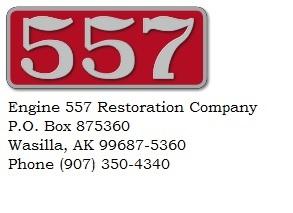Progress Report July 2014
July provided great weather which called some of our regular volunteers to the subsistence tasks which put food in the cellar for winter. The dip net salmon fishery, garden duty and visiting family members from the lower 49 all have their draw. Fortunately the bench is deep and revolving. The crew on July 19, 2014, consisted of Patrick Durand, Doug VanWingerden, Ron Dudley, Jerry Cunnington, Lynn Sawyer, Jerry Peters, George Fellers, Terry Douglas and Ken Elmore. Pretty good turnout for a Thursday weekday.
Charlie Lanning at Unique Machine supervised a major in-kind donation project refurbishing the trunnion bushing in the fulcrum casting for the equalizer beam supporting the engine truck. The trunnion before with it's pin shows the ravages of running without lubrication or bushing. The 3" pin survived to be used again in the new trunnion bushing arrived at by installing two oversized plugs and then line boring them to match the original drawings.
Larry Erickson used his surgical skills to remove these welded air tank brackets from the frame. They will be replaced with proper bolted fabrications so the tank can be removed easily.
Work continued on the tender trucks. James Keene is removing brake gear on the way to stripping to arrive at clean side frames. Our goal is to replace the wheels and axles and adapt the side frames to roller bearings.
Much of our time was devoted in preparation for the visit by Robert Franzen, our Professional Engineer with Steam Services of America.
Our Perkins powered Gardner Denver air compressor. here supports the pot sand blaster used for big jobs such as the frame and boiler interior. This work requires the positive air suit commonly manned by Dean Sawyer, Ken Elmore, Ron Dudly and on occasion by myself. All surfaces are normally needle scaled before sand blasting and then shortly receive protective coatings. Here the frame interior receives an epoxy primer applied by Jeff DeBroeck and Jerry Cunnington.
We do have a need for more machinists who can devote time to 557. Doug VanWingerdon has produced a number of replacement pieces while tooling up equipment in the shop.
Robert arrived July 25th and was in the engine house on July 26 and 27. His inspection of the inside of the boiler was completed and he provided instruction for the final cleaning and application of the Apexair paint finish.
In consultation with Jeff DeBroeck and Dick Morris a revised project time line was produced. Detailed instructions for preparation of the boiler for installation of the new firebox were prepared. A list of tooling was prepared and specification for needed welding equipment set.
On Monday July 28, Robert and I made the rounds of several suppliers lining up resources for the firebox work. First stop was at Greatland Welding and Machine where Gary Feaster committed to providing all the welding rod to be used in the exercise! Gary also arranged for a supply of propane for preheating.
Later in the morning we received a tour of Steelfab in Anchorage with Dan Demarco to review layout work for the new firebox crown and side sheets. We were very favorably impressed with the preparation being done to reproduce the original components in new certified material 7/16 thick.
Monday afternoon, Doug Engebretson, fellow 557 board member and ARRC C.O.O. arranged a meeting with Eileen M. Reilly, Alaska Railroad Corp VP Advanced Train Control Systems and Technology, to discuss the issue of Positive Train Control. In attendance were Robert Franzen of Steam Services of America, our P.E, for 557, Jerry Peters, 557 Master Electrician and myself, Patrick Durand. PTC is FRA mandated by 2017. How it can be implemented on steam locomotives is a question that Mr. Franzen will be raising with major operators of steam such as the Union Pacific, Norfolk Southern. Ken Elmore will be raising the question with Mr. Doyle McCormick and the operators of the 4449 and the S.P&S 700 in Portland.
I raise the subject of Positive Train Control because it represents a challenge not only of engineering but a potential cost of between $200,000 and $300.000 to meet a mandate that did not exists at the onset of the 557 restoration project. This is not insurmountable and does not alter our current restoration plan to return 557 to operation. We welcome comments from other operators of steam who will be subject to FRA mandated Positive Train Control.
The August progress report will be along shortly.
Patrick Durand, President
